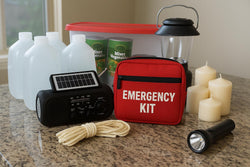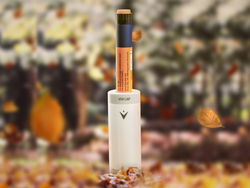Tempramed Blog
Fall Workouts and Insulin Storage: Why October Exercise Ruins Your Medication

Fall Workouts and Insulin Storage: Why October Exercise Ruins Your Medication
October's perfect weather crisp 50°F mornings, colorful trails, comfortable temperatures makes it peak outdoor fitness season. For active people with diabetes, these ideal conditions hide a serious problem: exercise-related insulin damage from extreme temperature cycling.
That charity 5K in perfect fall weather? Your insulin just experienced a 50-degree temperature swing in two hours.
Why Fall Exercise Destroys Insulin Effectiveness
Most people focus on carb timing and hydration during fall workouts. Almost nobody thinks about insulin temperature until unexplained blood sugar spikes reveal the damage is already done.
Here's what actually happens during a typical October morning run: You leave home at 7 AM when it's 45°F outside. Insulin sits in your running belt against your body. Within 15 minutes, body heat raises insulin temperature to 80°F. During intense exercise, your core temperature hits 98-100°F and insulin in direct contact experiences that heat. Cool down in 48°F air and insulin drops rapidly. Stop for post-run coffee and it sits in your 75°F car interior.
Total temperature range: 45°F to 100°F in under two hours. This repeated thermal cycling breaks down insulin molecular structure faster than constant temperature ever could.
The Body Heat Problem Nobody Talks About
Fall mornings feel comfortable at 50°F, but exercise changes everything. Your comfortable core temperature becomes insulin's enemy when stored in running belts (direct skin contact at 95-100°F), sports bras and compression gear (trapped heat with zero air circulation), jacket pockets (body-warmed fabric holding 85-90°F), or backpack hip belts (friction creating sustained hot spots).
The insulin experiencing these temperatures looks perfectly normal. No cloudiness, no particles, no visible changes. But research shows measurable potency loss occurs after exposure above 86°F, and exercise-generated heat easily exceeds 90°F against your body.
Damage accelerates because fall's comfortable temperatures allow longer workouts than summer heat permits. Two-hour hikes become common. Marathon training extends to four hours. All-day October hiking trips happen in ideal weather. Every additional hour means extended heat exposure and accumulated damage.
Post-Exercise Temperature Shock
The rapid cool-down after fall workouts creates a second damage mechanism. Wet clothing from sweat in 45°F air drops insulin temperature from 90°F to ambient cold in minutes. This thermal shock stresses insulin molecules differently than gradual temperature changes.
Repeated workouts mean repeated stress. Monday's 5K damage compounds Tuesday's trail run, Wednesday's boot camp, and Saturday's charity walk. Each temperature cycle progressively reduces effectiveness even when individual exposures stay within supposedly "safe" ranges.
The Car Storage Trap
Pre and post-workout car storage multiplies exercise exposure damage. Morning car interiors sit at 42°F during warm-up. You return to find solar heating raised interior temperature to 80°F or higher. Run afternoon errands with insulin in the heated car. Evening brings another temperature drop as everything cools overnight.
October sun heats car interiors 30-40°F above ambient temperature. That comfortable 50°F day creates an 85-90°F car interior by afternoon—adding another layer of heat exposure on top of exercise-related damage.
Common Storage Mistakes Active People Make
Running belts seem practical until you realize they maintain direct body contact for entire workouts, exposing insulin to full core temperature for hours. Jacket pockets during hikes trap body heat without air circulation. Backpacks transfer heat from your back throughout extended activities. Each method fails to protect insulin from exercise-generated temperature extremes.
The "it's only one workout" mindset ignores cumulative damage. Temperature exposure doesn't reset between activities. Last week's hiking damage adds to yesterday's run, today's workout, and tomorrow's training session. Progressive potency loss occurs invisibly until blood sugar patterns reveal the problem.
Professional Protection for Athletes
Active people with diabetes need insulin protection designed for intense physical activity. Temperature-controlled storage using Phase Change Material technology maintains optimal insulin temperature automatically, regardless of external conditions or exercise intensity.
The VIVI Cap regulates temperature from -4°F to 140°F external conditions without batteries or power. Compact design fits easily in backpacks or gear bags. Protection works continuously for 24-48 hours, covering extended activities and preventing both exercise heat and car storage damage.
For runners, keep insulin in temperature-controlled storage in your car or gear bag rather than running belts. Dose before workouts when possible, leaving insulin protected during exercise. Hikers should position temperature-controlled cases away from backpack back panels to minimize body heat transfer. Cyclists can secure protection to bike frames rather than using body-contact jersey pockets.
When Temperature Exposure Happens
If insulin experiences temperature extremes during workouts, increase blood glucose monitoring for 24 hours and watch for unexplained highs despite proper dosing. These patterns indicate compromised effectiveness. Replace questionable insulin rather than risking continued training with damaged medication—replacement costs less than complications from ineffective insulin during long workouts.
Visual inspection cannot detect temperature-related damage. Insulin looks normal even after significant potency loss. Blood sugar patterns reveal the truth days later when damage is already done.
The Investment Reality
Damaged insulin costs $50-$300 per pen or vial to replace. Active fall seasons easily require multiple replacements totaling $200-$1,000 or more. Temperature-controlled storage costs $150-$300 as a one-time investment providing years of protection. The system pays for itself after preventing one or two replacement incidents—typically within a single active season.
Beyond financial cost, damaged insulin compromises training quality, creates unpredictable blood sugar during workouts, and introduces DKA risk during extended activities. Professional protection eliminates these risks completely.
Year-Round Active Protection
October highlights fall-specific risks, but active people face insulin storage challenges across all seasons. Winter skiing and snowshoeing expose insulin to freezing temperatures. Spring brings variable weather during training. Summer creates extreme heat during races and long sessions. Professional temperature control protects insulin during every activity, every season.
Taking Action This October
Evaluate current workout insulin storage honestly. Running belts, pockets, and backpacks offer zero temperature protection during exercise. Research temperature-controlled options now, before peak fall fitness season. Order protection to ensure availability for upcoming races, hikes, and training sessions.
Practice using new storage during actual workouts to verify placement and security. Document blood sugar patterns to confirm insulin effectiveness with proper protection. Brief workout partners about storage needs so they understand your diabetes management during group activities.
The Bottom Line
October delivers ideal workout weather that masks serious insulin storage risks. Body heat during exercise, rapid temperature drops during cool-downs, car storage extremes, and extended outdoor exposure all compromise insulin effectiveness invisibly.
Active people with diabetes need protection that works as hard as they train. Temperature-controlled storage provides automatic, reliable protection during any activity without requiring monitoring, battery charging, or intervention during workouts.
Fall fitness goals and blood sugar control both depend on insulin that works when needed most. Protect your medication as seriously as you train. Your performance depends on it.




